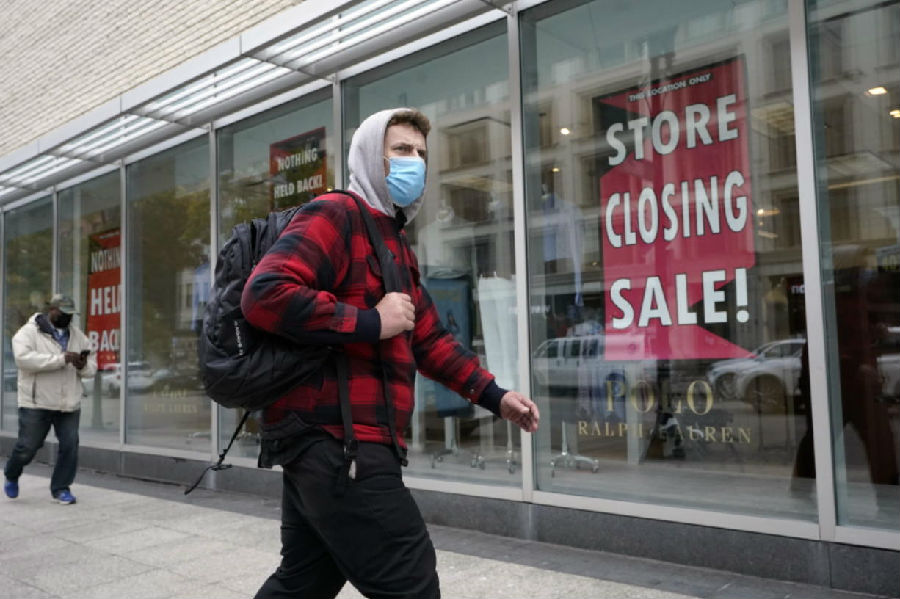United States
美國版塊
The economy
經濟
You must believe in spring
相信春天
The economic recovery no longer looks indestructible. A difficult winter looms
經濟復蘇的態勢看起來不再堅不可摧。艱難的寒冬即將來臨
In the summer and autumn America’s economy roared back. After peaking at nearly 15% of the labour force, unemployment fell like a stone, while in the third quarter GDP bounced from its lockdowninduced slump. The recovery of the world’s largest economy seemed oddly impervious to a second and then a third wave of coronavirus infections, even as economic activity in other parts of the world took a hit.
夏秋兩季,美國經濟復蘇。美國勞動力的失業率在達到近15%的峰值之后一落千丈。美國第三季度的國內生產總值從封鎖引發的衰退中反彈。奇怪的是,盡管世界其他地區的經濟活動受到打擊,但美國這個世界最大的經濟體的復蘇似乎絲毫沒有受到第二波、第三波冠狀病毒感染的影響。
Yet there are growing concerns that the run of surprisingly good economic news is over, at least until a vaccine becomes widely available. In congressional testimony on December 1st Jerome Powell, the chairman of the Federal Reserve, said the recovery was slowing, while the decision on the same day by a bipartisan group of senators to release a proposal for a stimulus package reflects the same fears. The jobs report for November, which was to be released shortly after The Economist went to press, will probably be a downbeat one by recent standards— and whatever it shows, it is old news, since the surveys for the report were taken some weeks ago. More up-to-date figures show that the recovery has lost steam. That is bad news for the millions who remain out of work, as well as the rapidly growing share of Americans who are living in poverty.
然而,越來越多的人擔心,一連串出人意料的經濟利好消息已經結束,至少在疫苗普及之前。12月1日,美國聯邦儲備委員會主席杰羅姆•鮑威爾在國會作證時表示,經濟復蘇正在放緩,而美國參議員兩黨小組在同日公布一項刺激方案的決定也反映了同樣的擔憂。《經濟學人》付印后不久即將發布的11月就業報告,按照最近的標準來看,可能會是一份悲觀的報告。不管就業報告的內容是什么,都勢必會是舊消息,因為該報告的調查是在幾周前進行的。更多最新數據顯示,經濟復蘇已失去動力。這對數百萬失業者來說是個壞消息,對急速增多的貧困美國人來說也是個壞消息。

Official statistics tend to be produced with long lags. So during the pandemic economists have turned to “high-frequency” data, largely produced by the private sector and generated by consumers’ and firms’ transactions, to measure the economy in real time. Wall Street banks now routinely provide clients with updates on everything from weekly electricity consumption to daily hotel bookings. The high-frequency data do not map onto the official kind perfectly. But they are useful for finding turning-points. They pinpointed the start of the downturn in March long before the official statistics could.
官方統計數據往往滯后太久。因此,在大流行期間,經濟學家們轉向了“高頻”數據,這些數據主要由私營企業發出,由消費者和企業的交易產生,用來實時衡量經濟。華爾街銀行目前定期向客戶提供所有最新消息,從每周用電量到每日酒店預訂。高頻數據并不能完美地映射到官方數據。但高頻數據有助于尋找轉折點。他們早在官方統計數據公布很久之前就確定了三月經濟衰退的開始時間。
America is at another turning-point. STR, a data provider, finds that in the week ending November 21st hotels were running at 40% occupancy, down from 50% only weeks ago. The number of diners in restaurants has sharply declined in recent weeks, suggest data from OpenTable, a booking platform, with the fall even steeper in the states hardest hit by the virus. A recovery in air-passenger numbers appears to have ground to a halt as well.
美國正處于另一個轉折點。數據提供方英國信達集團發現,在截至11月21日的一周內,酒店的入住率為40%,低于幾周前的50%。訂餐平臺OpenTable的數據顯示,近幾周來,餐館就餐人數急劇下降,受病毒影響最嚴重的州的下降幅度更大。航空客運人數的回升似乎也已陷入停頓。
譯文由可可原創,僅供學習交流使用,未經許可請勿轉載。











